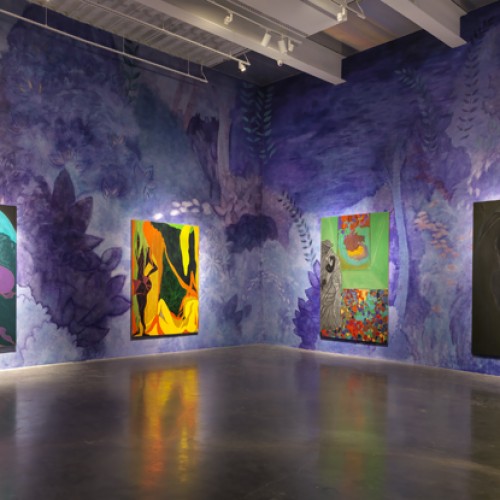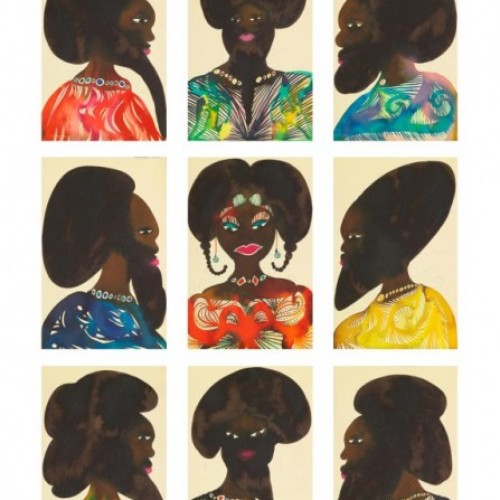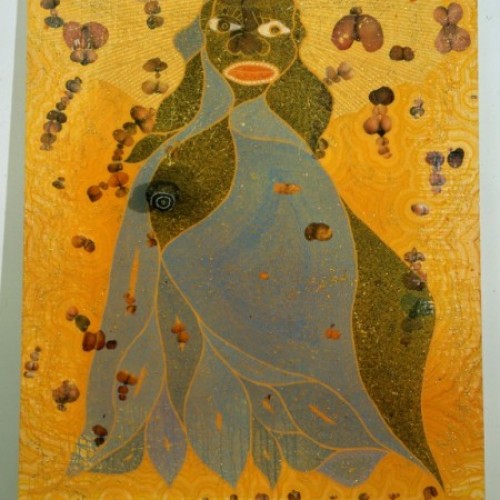Chris Ofili: Night and Day
Chris Ofili has been producing paintings for the past two decades that have managed to captivate and bewilder audiences. A member of the Young British Artists– a group of British artists who began exhibiting together in 1988, Ofili managed to distinguish himself from the rest early on. In “Chris Ofili: Night and Day” which on display at the New Museum through January 25 many works spanning his illustrious career are on display. The exhibition was organized by Massimiliano Gioni, the New Museum’s artistic director, its curator, Gary Carrion-Murayari; and assistant curator Margot Norton.
Ofili was Born in 1968, to Nigerian parents. At age eleven, he and his family moved back to Nigeria. Ofili went onto attend the Chelsea School of Art where he received his BFA in 1991 and then the Royal Academy of Art in 1993. It was these early experiences with living abroad and his art training, which would play an influence in the work he would create. In 2003, he was the recipient of the prestigious Turner Prize and also represented the United Kingdom in the Venice Biennale the same year. Much of Ofili’s work deals with issues surrounding race, class and gender which is evident in the work featured in “Night and Day.”
The exhibition spans three floors of the New Museum’s space and explores six distinct bodies of work that Oifli produced over the last twenty years. When you first enter the galley space, you are confronted by over seventy small framed paintings. These works entitled, Afromuses (Couples) consists of twenty-six diptychs done in water color and pencil of various couples in different poses and outfits. Another series of them, Untitled (Afromuses) features sixty four parts and is done of various men, women and children. These small paintings were produced from 1995 to 2005 and were typically done in one sitting. The portraits cover almost an entire gallery wall and the sheer number of them is overwhelming.
Within another room on the same floor there are several paintings from the 1990s would come to define Ofili’s distinctive style— textured, painted canvases which use several kings of materials including elephant dung, resin, paint and glitter. During this time, Ofili was drawing from a variety of sociocultural sources ranging from religious iconography to Blaxploitation films. Many of these earlier paintings are shown sitting against the wall on top of small, intricate, vessel like objects which becomes part of the work. One such painting is The Holy Virgin Mary, which was part of the traveling exhibition Sensation. This painting sparked debate in 2000, while on display at the Brooklyn Museum prompting then mayor Rudy Giuliani to describe the work as “sick.” The Holy Virgin Mary was also defaced during that exhibition as well. There is also another series of paintings from the early 2000s which are also featured on this floor. These specific images use a black, red and green pallet which is in direct reference to Marcus Garvey’s pan African movement. Despite the limited color palette, they are vibrant and full of life.
The third floor features paintings that were produced during Ofili’s 2005 move from London to Trinidad which pushed his work into a new direction. This transition allowed for the development of his “Blue Riders” series. The name comes from “from the early twentieth-century artist group that sought spirituality by connecting visual art with music.” Ofili has gone on to develop this work and within “Night and Day” there are nine paintings which are being featured together for the first time in “architectural space which was designed by the artist.” These works are mostly composed in blue colors which seek to illicit “the blue light of twilight and the soulfulness of blues music.”
Ofili’s most recent pieces feature complex landscapes, characters from folklore and seem reminiscent of artists Henri Matisse and Paul Gauguin. The exhibition also includes work from the “Metamorphosis” series. Taking it’s name from a poem with the same title by “Ovid which illustrated the ancient Roman author’s stories of gods and humans, including the tale of the goddess Diana and the hunter Actaeon.” It is both the complex subject matter of his work and the lush imagery that Ofili produces which makes this exhibition one that is not to be missed.
“Chris Ofili: Night and Day” is on display at the New Museum until January 25th.
–Anni Irish




